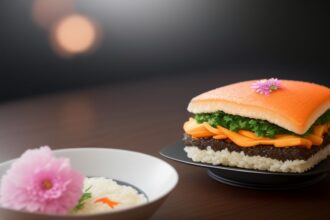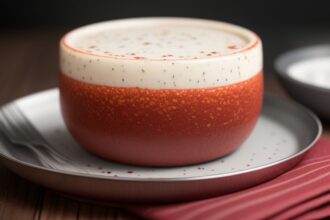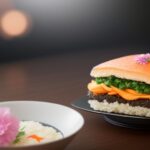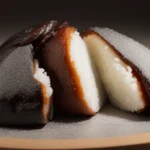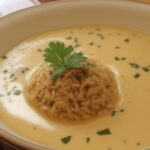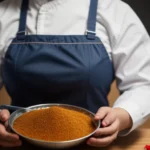Thai Desserts: A Sweet Ending to a Spicy Meal
When one thinks of Thai cuisine, flavorful curries, aromatic spices, and fiery chilies often come to mind. However, what many may not realize is that Thai cuisine also boasts a delectable array of desserts that are just as enticing as the main courses. From creamy coconut desserts to sticky rice treats, Thai desserts offer a sweet and satisfying end to a spicy meal. In this article, we will explore the delicious world of Thai desserts and delve into the diverse flavors and textures that make them so irresistible.
1. A Sweet Tradition: The History of Thai Desserts
Thai desserts have a long and rich history that dates back to ancient times. Influenced by the culinary traditions of neighboring countries such as China and India, Thai desserts have evolved over the centuries to become a unique and distinct part of Thai cuisine. Originally, Thai desserts were made using simple ingredients such as rice, coconut, and sugar, but over time, they have become more sophisticated and diverse, incorporating a wide range of flavors and textures.
2. The Essence of Thai Desserts: Sweet, Salty, Sour, and Spicy
One of the defining characteristics of Thai desserts is their balance of flavors. Thai desserts often combine sweet, salty, sour, and spicy elements to create a harmonious and complex taste profile. For example, many Thai desserts use coconut milk and palm sugar for sweetness, while also incorporating salty and sour ingredients such as fish sauce and tamarind to add depth and complexity to the dish. This unique flavor profile sets Thai desserts apart from other cuisines and makes them a truly unforgettable experience.
3. Coconut Heaven: The Role of Coconut in Thai Desserts
Coconut plays a central role in many Thai desserts, adding a rich and creamy texture as well as a subtle, sweet flavor. Coconut milk, made by pressing the flesh of the coconut, is a common ingredient in Thai desserts, used to create creamy custards, smooth puddings, and flavorful curries. Coconut also features prominently in Thai snacks and candies, such as coconut jelly and coconut brittle, adding a tropical twist to these sweet treats.
4. Sticky Rice Delights: The Versatility of Sticky Rice in Thai Desserts
Sticky rice, also known as glutinous rice, is another staple ingredient in Thai desserts. This short-grain rice is cooked until sticky and chewy, making it a perfect base for a variety of sweet treats. Sticky rice is often steamed with coconut milk and sugar to create a sweet and fragrant dessert known as khao niew mamuang, or mango sticky rice. Other popular sticky rice desserts include khao niew sangkaya, a coconut custard served with sticky rice, and khao niew thet, sticky rice balls filled with sweet coconut cream.
5. Sweet and Savory: The Intriguing Combination of Thai Desserts
One of the most unique aspects of Thai desserts is the incorporation of savory ingredients into sweet dishes. This combination of sweet and savory creates a depth of flavor that is truly unparalleled. For example, in the classic dish of khanom krok, a type of coconut pancake, sweet coconut milk is combined with salty green onions to create a sweet and savory treat that is both indulgent and satisfying. Other savory-sweet desserts include khanom bueang, or Thai crepes filled with coconut cream and savory toppings, and khanom bua loy, sticky rice balls served in a savory broth.
6. Flavors of Thailand: Exploring the Diverse Range of Thai Desserts
Thai desserts come in a wide variety of flavors and textures, from creamy custards to sticky rice treats to refreshing fruit salads. Some popular Thai desserts include:
– Khanom thungtag (coconut jelly): A sweet and refreshing coconut jelly dessert that is often served in coconut shells.
– Khanom gluay (banana cake): A moist and flavorful banana cake made with ripe bananas and coconut milk.
– Kluai buat chi (banana in coconut milk): A simple and elegant dessert featuring ripe bananas cooked in sweet coconut milk.
– Khanom chan (layered jelly cake): A multilayered dessert made with coconut milk, rice flour, and sugar, creating a colorful and flavorful treat.
– Thong yip (flower-shaped egg yolk tart): A delicate and ornate dessert made with egg yolks and sugar, shaped like beautiful flowers.
7. The Art of Thai Desserts: A Feast for the Eyes and the Palate
Thai desserts are not only delicious but also visually stunning, often featuring intricate shapes, vibrant colors, and elaborate garnishes. Thai dessert makers take great care in crafting their creations, using traditional techniques and tools to create beautiful and ornate desserts that are as pleasing to the eye as they are to the palate. Thai desserts are often served in ornate serving dishes, such as banana leaf cups, coconut shells, and intricate molds, adding to the aesthetic appeal of these delightful treats.

8. The Joy of Sharing: Thai Desserts as a Symbol of Generosity
In Thai culture, the act of sharing food is a symbol of generosity and hospitality, and this tradition extends to Thai desserts as well. Thai desserts are often shared among friends and family at social gatherings and celebrations, such as weddings, festivals, and religious events. This act of sharing not only enhances the enjoyment of the dessert but also fosters a sense of community and togetherness among those who partake in the sweet treats.
9. A Healthy Indulgence: The Nutritional Benefits of Thai Desserts
While Thai desserts are undeniably indulgent and decadent, many of them also offer nutritional benefits. For example, coconut milk, a common ingredient in Thai desserts, is rich in healthy fats and medium-chain triglycerides, which have been linked to numerous health benefits, including improved heart health and weight management. Additionally, many Thai desserts are made with fresh fruits, such as mangoes, bananas, and durian, which are high in vitamins, minerals, and antioxidants, making them a healthy and refreshing option for those with a sweet tooth.
10. A Culinary Delight: Pairing Thai Desserts with Drinks
When it comes to enjoying Thai desserts, the possibilities are endless. Thai desserts can be paired with a variety of beverages to enhance their flavor and elevate the dining experience. One popular pairing is Thai iced tea, a sweet and creamy beverage made with black tea, condensed milk, and spices, which complements the richness of many Thai desserts. For a refreshing option, consider pairing Thai desserts with coconut water or a tropical fruit smoothie, such as mango or pineapple, to create a harmonious and satisfying combination.
11. The Global Appeal of Thai Desserts: Spreading Sweetness Around the World
In recent years, Thai desserts have gained popularity around the world, with restaurants and food enthusiasts embracing the unique flavors and textures of these sweet treats. Thai desserts can now be found on menus in restaurants and cafes across the globe, from New York City to Tokyo to Paris, delighting diners with their exotic flavors and vibrant colors. The global appeal of Thai desserts is a testament to the creativity and artistry of Thai chefs, who continue to innovate and create new and exciting desserts that captivate and inspire food lovers everywhere.
12. Embracing Thai Desserts: Experience the Sweet Side of Thai Cuisine
Whether you are a seasoned Thai food aficionado or a newcomer to the world of Thai cuisine, exploring Thai desserts is a delicious and rewarding experience. From creamy coconut puddings to sticky rice delicacies to refreshing fruit salads, Thai desserts offer a diverse and tantalizing array of flavors and textures that are sure to satisfy your sweet tooth. So why not indulge in a sweet and satisfying end to your next Thai meal and experience the joy and delight of Thai desserts for yourself?
13. The Future of Thai Desserts: Innovation and Creativity in the Culinary World
As Thai cuisine continues to evolve and innovate, so too do Thai desserts. Chefs and dessert makers are constantly experimenting with new ingredients, techniques, and flavor combinations to create fresh and exciting desserts that push the boundaries of traditional Thai cuisine. From modern twists on classic desserts to innovative fusion creations, the future of Thai desserts is bright and promising, offering endless possibilities for culinary exploration and creativity.
14. Exploring Authentic Thai Desserts: A Culinary Journey to Thailand
For those looking to experience authentic Thai desserts in their truest form, a culinary journey to Thailand is in order. In Thailand, visitors can explore bustling markets, vibrant street food stalls, and traditional dessert shops to sample a wide array of sweet treats that are not only delicious but also deeply rooted in Thai culture and tradition. From the bustling streets of Bangkok to the serene beaches of Phuket, Thailand offers a culinary adventure like no other, with Thai desserts serving as the sweet and satisfying conclusion to a memorable dining experience.
15. Conclusion: Savoring the Sweetness of Thai Desserts
In conclusion, Thai desserts offer a sweet and satisfying end to a spicy and flavorful meal, with their unique flavors, textures, and presentations captivating food lovers around the world. From coconut custards to sticky rice treats to fruit salads, Thai desserts provide a diverse and delicious array of options that are sure to please even the most discerning palates. So the next time you find yourself craving something sweet, why not indulge in the exotic and enticing world of Thai desserts and experience the joy and delight that these sweet treats have to offer?
FAQs about “Thai Desserts: A Sweet Ending to a Spicy Meal”
- What distinguishes “Thai Desserts: A Sweet Ending to a Spicy Meal” as a guide to Thai cuisine? This book offers an exploration of the diverse and delicious world of Thai desserts, providing insights into traditional recipes, ingredients, and techniques that add a sweet touch to the spicy Thai dining experience.
- Which types of Thai desserts are featured in this guide? “Thai Desserts” features a wide array of Thai desserts, including classics like mango sticky rice, coconut ice cream, sticky rice with durian, Thai custard, and various types of colorful and flavorful Thai sweets.
- Are specific Thai ingredients and cooking methods highlighted in this book for making desserts? Yes, this book highlights specific Thai ingredients such as coconut milk, palm sugar, glutinous rice, and tropical fruits, along with traditional cooking methods and techniques used in Thai dessert-making.
- How does this book celebrate the cultural and culinary heritage of Thai desserts? This book celebrates the cultural and culinary heritage of Thai desserts by exploring their origins, cultural significance, and role in Thai celebrations and festivals. It also delves into the symbolism and traditions associated with Thai sweet treats.
- Can readers expect to find practical recipes and tips for making Thai desserts at home in this book? Absolutely! “Thai Desserts” provides practical recipes, cooking tips, and step-by-step instructions for making authentic Thai desserts in the comfort of your own kitchen. Whether you’re a beginner or a seasoned baker, this book has something sweet for everyone.
Advantages:
- Clear Focus: The title “Thai Desserts: A Sweet Ending to a Spicy Meal” clearly indicates that the content will focus specifically on Thai desserts, which can be appealing to readers with a sweet tooth or those interested in exploring Thai cuisine beyond savory dishes.
- Relevance: By highlighting the contrast between the spiciness of Thai cuisine and the sweetness of Thai desserts, the title emphasizes the complementary nature of these flavors, suggesting that Thai desserts provide a satisfying conclusion to a flavorful Thai meal.
- Culinary Exploration: The title invites readers to explore the diverse and intricate world of Thai desserts, fostering a deeper appreciation for the unique ingredients, flavors, and techniques that characterize traditional Thai sweet treats.
- Educational Value: As a guide to Thai desserts, the title offers readers valuable insights into the cultural significance and historical background of these confections, enriching their understanding of Thai culinary traditions and food culture.
- Practicality: Readers interested in cooking Thai food at home may find the title useful as it suggests dessert options to complement homemade Thai meals, providing inspiration and guidance for incorporating Thai desserts into their culinary repertoire.
Disadvantages:
- Narrow Scope: While the title focuses on Thai desserts, it may overlook other aspects of Thai cuisine that readers might be interested in exploring, such as savory dishes, street food, or beverages.
- Cultural Oversimplification: Focusing solely on the sweetness of Thai desserts may oversimplify Thai cuisine and overlook its complexity, diversity, and balance of flavors beyond just sweet and spicy.
- Audience Limitation: The title may primarily appeal to readers with a specific interest in desserts or Thai cuisine, potentially excluding those who prefer savory foods or are seeking a broader overview of Thai culinary traditions.
- Accessibility: Some ingredients used in Thai desserts may be difficult to find outside of Thailand or specialty Asian markets, limiting the practicality of preparing these desserts for readers in certain regions.
- Subjectivity: The title’s assertion that Thai desserts provide a satisfying ending to a spicy meal may not resonate with all readers, as taste preferences can vary widely and some individuals may prefer to end their meal with a different type of dessert or no dessert at all.



